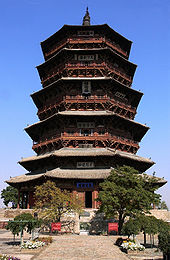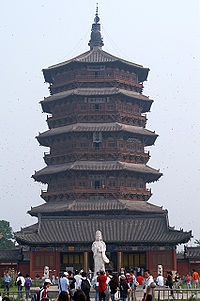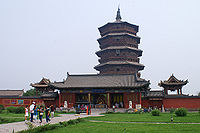
Pagoda of Fogong Temple
Encyclopedia

Ying County
Ying County is a district of Shanxi, China. It is under the administration of Shuozhou city.-References:*...
, Shanxi
Shanxi
' is a province in Northern China. Its one-character abbreviation is "晋" , after the state of Jin that existed here during the Spring and Autumn Period....
province, China
China
Chinese civilization may refer to:* China for more general discussion of the country.* Chinese culture* Greater China, the transnational community of ethnic Chinese.* History of China* Sinosphere, the area historically affected by Chinese culture...
, is a wooden Chinese pagoda
Chinese pagoda
Chinese Pagodas are a traditional part of Chinese architecture. In addition to religious use, since ancient times Chinese pagodas have been praised for the spectacular views which they offer, and many famous poems in Chinese history attest to the joy of scaling pagodas.-History:The pagoda is...
built in 1056, during the Khitan
Khitan people
thumb|250px|Khitans [[Eagle hunting|using eagles to hunt]], painted during the Chinese [[Song Dynasty]].The Khitan people , or Khitai, Kitan, or Kidan, were a nomadic Mongolic people, originally located at Mongolia and Manchuria from the 4th century...
-led Liao Dynasty
Liao Dynasty
The Liao Dynasty , also known as the Khitan Empire was an empire in East Asia that ruled over the regions of Manchuria, Mongolia, and parts of northern China proper between 9071125...
. The pagoda was built by Emperor Daozong of Liao
Emperor Daozong of Liao
Emperor Daozong of Liao , born Yelü Hongji or Yehlu Hongji , was an emperor of the Liao dynasty, a kingdom of the Khitan people in what is now northeastern China. Succeeding his father, Xingzong, in 1055, Daozong ruled until he was murdered in 1101. He was succeeded by his grandson, Tianzuodi...
(Hongji) at the site of his grandmother's family home. The pagoda, which has survived several large earthquakes throughout the centuries, reached a level of such fame within China that it was given the generic nickname of the "Muta" .
The pagoda stands on a 4 m (13 ft) tall stone platform, has a 10 m (33 ft) tall steeple, and reaches a total height of 67.31 m (220.83 ft) tall; it is the oldest existent fully wooden pagoda still standing in China. Although it is the oldest fully wooden pagoda in China, the oldest existent pagoda is the 6th century Songyue Pagoda
Songyue Pagoda
The Songyue Pagoda , constructed in 523 AD, is located at the Songyue Monastery on Mount Song, in Henan province, China. Built during the Northern Wei Dynasty, this pagoda is one of the few intact sixth-century pagodas in China and is also the earliest known Chinese brick pagoda...
made of brick and the oldest existent wooden buildings in China date back to the mid Tang Dynasty
Tang Dynasty
The Tang Dynasty was an imperial dynasty of China preceded by the Sui Dynasty and followed by the Five Dynasties and Ten Kingdoms Period. It was founded by the Li family, who seized power during the decline and collapse of the Sui Empire...
(618–907), which are Buddhist temple halls found at Mount Wutai.
History




Datong
Datong is a prefecture-level city in northern Shanxi Province of North China, located a few hundred kilometres west by rail from Beijing with an elevation of...
. The Gujin Tushu Jicheng
Gujin Túshu Jíchéng
The Gujin Tushu Jicheng , is a vast encyclopaedic work written in China during the reigns of Qing emperors Kangxi and Yongzheng, completed in 1725. The work was headed initially by scholar Chen Menglei , and later by Jiang Tingxi. It contained 800,000 pages and over 100 million Chinese characters...
encyclopedia published in 1725—written during the reigns of Kangxi
Kangxi Emperor
The Kangxi Emperor ; Manchu: elhe taifin hūwangdi ; Mongolian: Энх-Амгалан хаан, 4 May 1654 –20 December 1722) was the fourth emperor of the Qing Dynasty, the first to be born on Chinese soil south of the Pass and the second Qing emperor to rule over China proper, from 1661 to 1722.Kangxi's...
and Yongzheng
Yongzheng Emperor
The Yongzheng Emperor , born Yinzhen , was the fifth emperor of the Manchu Qing Dynasty and the third Qing emperor from 1722 to 1735. A hard-working ruler, Yongzheng's main goal was to create an effective government at minimal expense. Like his father, the Kangxi Emperor, Yongzheng used military...
in the Qing
Qing Dynasty
The Qing Dynasty was the last dynasty of China, ruling from 1644 to 1912 with a brief, abortive restoration in 1917. It was preceded by the Ming Dynasty and followed by the Republic of China....
—states that a different pagoda built between the years 936–943 stood previously at the site before the present one of 1056 was built. The same statement appears in the Shanxi tongzhi (Record of Shanxi Province) and the Yingzhou xuzhi (Record of Ying Prefecture, Continued). The Yingzhou zhi (Record of Ying Prefecture)—edited by Tian Hui during the reign of the Wanli Emperor
Wanli Emperor
The Wanli Emperor was emperor of China between 1572 and 1620. His era name means "Ten thousand calendars". Born Zhu Yijun, he was the Longqing Emperor's third son...
(r. 1572–1620) of the Ming Dynasty
Ming Dynasty
The Ming Dynasty, also Empire of the Great Ming, was the ruling dynasty of China from 1368 to 1644, following the collapse of the Mongol-led Yuan Dynasty. The Ming, "one of the greatest eras of orderly government and social stability in human history", was the last dynasty in China ruled by ethnic...
—states that the pagoda was funded and erected in 1056 by a Buddhist monk
Bhikkhu
A Bhikkhu or Bhikṣu is an ordained male Buddhist monastic. A female monastic is called a Bhikkhuni Nepali: ). The life of Bhikkhus and Bhikkhunis is governed by a set of rules called the patimokkha within the vinaya's framework of monastic discipline...
named Tian. In compiling a record for Ying County, Tian Hui of the late Ming Dynasty researched the history of the pagoda and recorded the history of its repairs in his Zhongxiu Fogongsi ta zhi. The placard on the third story of the pagoda listed that periodic repairs were conducted in the years 1195 and 1471. While piecing together the history of the pagoda, Tian Hui never came across any information to suggest that the pagoda had a predecessor built from 936 to 943, as other texts suggest.
In confirming the date of 1056 and not the years 936–943, Zhang Yuhuan writes in his Zhongguo gudai jianzhu jishu shi (1985) that the Wenwu Laboratory determined various wooden components from the second to fifth floors of the pagoda to be 930 to 980 years old. Other evidence to suggest the later date includes the fact that the foster mother of Emperor Xingzong
Emperor Xingzong of Liao
Emperor Xingzong of Liao , born Yelü Zongzhen , was an emperor of the Liao Dynasty. He reigned from 25 June 1031 to 28 August 1055....
was a native of Yingzhou. Xingzong's son Hongji (Emperor Daozong) was also raised in Ying County due to his following of the Khitan
Khitan people
thumb|250px|Khitans [[Eagle hunting|using eagles to hunt]], painted during the Chinese [[Song Dynasty]].The Khitan people , or Khitai, Kitan, or Kidan, were a nomadic Mongolic people, originally located at Mongolia and Manchuria from the 4th century...
custom of raising Yelu clan
Yelu clan
The Yelü clan of the Khitan people assumed leadership of the Khitan nation in 907 when Abaoji became khan of the Khitan nation. The clan, written "i.ra.u.ud" in the Khitan language, maintained that leadership through the fall of the Liao Dynasty in the 1120s...
sons within the families of their mothers. Hongji was also known as a devout Buddhist; the pagoda (following the tradition of the stupa
Stupa
A stupa is a mound-like structure containing Buddhist relics, typically the remains of Buddha, used by Buddhists as a place of worship....
) symbolized the death of the Buddha
Gautama Buddha
Siddhārtha Gautama was a spiritual teacher from the Indian subcontinent, on whose teachings Buddhism was founded. In most Buddhist traditions, he is regarded as the Supreme Buddha Siddhārtha Gautama (Sanskrit: सिद्धार्थ गौतम; Pali: Siddhattha Gotama) was a spiritual teacher from the Indian...
, which Hongji might have associated with his deceased father, the Xingzong Emperor. Steinhardt writes "only something like the memory of an imperial youth might account for the construction of such a phenomenal building in such an out-of-the way place." Also, the 1050s was a decade which marked the end of a Buddhist kalpa, which would signify the Pagoda of Fogong Temple as an "ultimate death shrine to the Buddha of the age," according to historian Nancy Steinhardt. This occurred at roughly the same time in which Fujiwara no Yorimichi
Fujiwara no Yorimichi
' , son of Michinaga, was a Japanese Court noble. He succeeded his father to the position of Sesshō in 1017, and then went on to become Kampaku from 1020 until 1068...
of Japan
Japan
Japan is an island nation in East Asia. Located in the Pacific Ocean, it lies to the east of the Sea of Japan, China, North Korea, South Korea and Russia, stretching from the Sea of Okhotsk in the north to the East China Sea and Taiwan in the south...
converted the Phoenix Hall of his father Fujiwara no Michinaga
Fujiwara no Michinaga
represents the highpoint of the Fujiwara regents' control over the government of Japan.-Early life:He was the fourth or fifth son of Fujiwara no Kaneie by his wife Tokihime, daughter of Fujiwara no Nakamasa...
's residence at Byōdō-in
Byodo-in
is a Buddhist temple in the city of Uji in Kyoto Prefecture, Japan. It is jointly a temple of the Jōdo-shū and Tendai-shū sects.- History :...
into a temple meant to guide souls into the Buddhist afterlife (according to Pure Land Buddhism
Pure Land Buddhism
Pure Land Buddhism , also referred to as Amidism in English, is a broad branch of Mahāyāna Buddhism and currently one of the most popular traditions of Buddhism in East Asia. Pure Land is a branch of Buddhism focused on Amitābha Buddha...
).
The pagoda was placed at the center of the temple grounds, which used to be called Baogong Temple until its name was changed to Fogong in 1315 during the Yuan Dynasty
Yuan Dynasty
The Yuan Dynasty , or Great Yuan Empire was a ruling dynasty founded by the Mongol leader Kublai Khan, who ruled most of present-day China, all of modern Mongolia and its surrounding areas, lasting officially from 1271 to 1368. It is considered both as a division of the Mongol Empire and as an...
. Although the size of the temple grounds were described as being gigantic during the Jurchen-led Jin Dynasty (1115–1234), the temple began to decline during the Ming Dynasty.
The Yingzhou zhi records that there was a total of seven earthquakes between the years 1056 and 1103, yet the tower stood firm. In its entire history before the 20th century, the pagoda needed only ten minor repairs. However, considerable repairs were needed after Japanese soldiers shot more than two hundred rounds into the pagoda during the Second Sino-Japanese War
Second Sino-Japanese War
The Second Sino-Japanese War was a military conflict fought primarily between the Republic of China and the Empire of Japan. From 1937 to 1941, China fought Japan with some economic help from Germany , the Soviet Union and the United States...
. While repairing the pagoda in 1974, renovators found Liao Dynasty texts of Buddhist sutras and other documents that were printed, attesting to the widespread technological use of movable type printing
Movable type
Movable type is the system of printing and typography that uses movable components to reproduce the elements of a document ....
that developed within the neighboring Song Dynasty.
Features
The pagoda features fifty-four different kinds of bracket armsDougong
Dougong is a unique structural element of interlocking wooden brackets, one of the most important elements in traditional Chinese architecture....
in its construction, the greatest amount for any Liao Dynasty structure. Between each outer story of the pagoda is a mezzanine layer
Mezzanine (architecture)
In architecture, a mezzanine or entresol is an intermediate floor between main floors of a building, and therefore typically not counted among the overall floors of a building. Often, a mezzanine is low-ceilinged and projects in the form of a balcony. The term is also used for the lowest balcony in...
where the bracket arms are located on the exterior. From the exterior, the pagoda seems to have only five stories and two sets of rooftop eaves for the first story, yet the pagoda's interior reveals that it has nine stories in all. The four hidden stories can be indicated from the exterior by the pagoda's pingzuo (terrace balconies
Terrace (building)
A terrace is an outdoor, occupiable extension of a building above ground level. Although its physical characteristics may vary to a great degree, a terrace will generally be larger than a balcony and will have an "open-top" facing the sky...
). A ring of columns support the lowest outstretching eaved roof on the base floor, while the pagoda also features interior support columns. A statue of the Buddha Sakyamuni sits prominently in the center of the first floor of the pagoda, with an ornate zaojing (caisson)
Caisson (Asian architecture)
The Caisson , also referred to as a caisson ceiling, or spider web ceiling, in East Asian architecture is an architectural feature typically found in the ceiling of temples and palaces, usually at the centre and directly above the main throne, seat, or religious figure.The caisson is generally a...
above its head (the pagoda is named Sakyamuni Pagoda due to this statue). A zaojing is also carved into the ceiling of every story of the pagoda. The windows on the eight sides of the pagoda provide views of the countryside, including Mount Heng
Mount Heng (Shanxi)
Heng Shan or Heng Mountain in Shanxi Province is one of the Five Sacred Mountains of Taoism. At 2,017 m, it is one of the five tallest peaks in China Proper. Heng Shan in Shanxi Province is sometimes known as the Northern Heng Shan, and the one in Hunan Province as Southern Heng Shan...
and the Songgan River. On a clear day, the pagoda can be seen from a distance of 30 km (18.6 mi).
Preservation
The Pagoda of Fogong Temple and its surroundings are protected by the SACHState Administration of Cultural Heritage
State Administration of Cultural Heritage is an administrative agency subordinate to the Ministry of Culture. It is responsible for relics and managing museums on mainland China...
branch of the Chinese government
People's Republic of China
China , officially the People's Republic of China , is the most populous country in the world, with over 1.3 billion citizens. Located in East Asia, the country covers approximately 9.6 million square kilometres...
, and over 1 million dollars have already been committed to the research on repairing and renovating the precariously standing millennium-old building. In May of 2011, Shanxi provincial authorities stated that the application for the pagoda should be finished by July of 2011 for it to be included on the UNESCO
World Heritage Site
A UNESCO World Heritage Site is a place that is listed by the UNESCO as of special cultural or physical significance...
list of protected world heritage relics by 2013.

